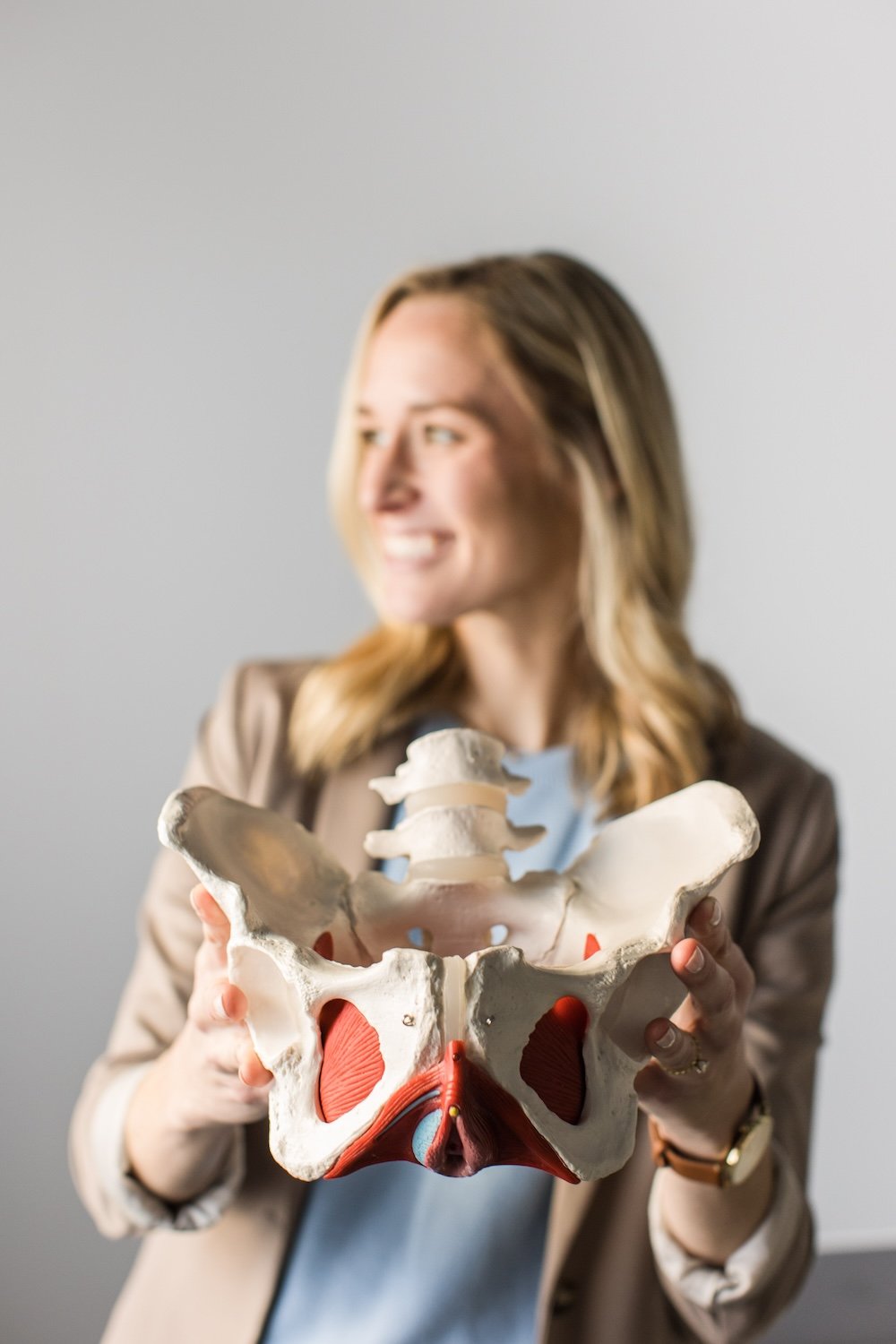
Pelvic Floor Physical Therapy
Pelvic Wellness specializes in treating the pelvis and pelvic floor muscles, aiming to normalize any dysfunctions associated with these areas.
Just like any other orthopedic issue, we assess muscle strength, joint mobility, coordination, and function to understand how they contribute to your symptoms. We focus on integrating the pelvic floor into movement and examine how it interacts with other parts of the body.
We proudly provide pelvic floor therapy to people of all genders and ages.
Conditions We Treat
Pregnancy and Postpartum
We treat women experiencing symptoms during pregnancy and the postpartum period. Common symptoms during the perinatal time that are extremely treatable include SI pain, low back pain, pelvic pain, urinary dysfunction, and sexual dysfunction. We are experts in helping you return to life and e exercise during the postpartum period.
Birth Preparation
We help expectant mothers prepare for the delivery they envision. Preparing the body for labor and delivery can help optimize the outcome of delivery. Our Birth Prep sessions will teach you preventative techniques to optimize postpartum healing and minimize long-term pelvic health symptoms. Learn more about our Birth Prep sessions.
Fertility Optimization
Dr. Nicole is a Certified Mercier Therapist. Mercier Therapy is a deep organ visceral manipulation technique that can be used alone or in conjunction with medical interventions for fertility. This technique is a conservative treatment to optimize chances of conception. Learn more about fertility optimization and Mercier Therapy.
Pelvic Pain
We treat those of all genders experiencing pelvic pain. This can include pain in the SI joints, groin, vagina, penis, rectum, abdomen, low back and hips. Pelvic pain can sometimes be linked to other conditions such as interstitial cystitis, endometriosis, prostatitis, and uterine fibroids but other times has with no associated cause.
Male Pelvic Health
We treat male patients for pelvic floor conditions including pain, urinary dysfunction, bowel dysfunction and sexual dysfunction. We help men recover from surgeries that might cause them to be left with urinary or sexual symptoms. Men have similar anatomy to women in the pelvic floor musculature and we have advanced training in providing treatment to men.
Bowel and Bladder Dysfunction
The pelvic floor muscles have a close relationship with the bowel and bladder, playing a critical role in how these systems funcitonp We help those heal who are dealing with urinary incontinence, painful urination, urinary frequency, urinary urgency and urinary hesitancy, as well as bowel conditions such as IBS, consitation, fecal icotince and fecal smearing.
Pelvic Organ Prolapse
We treat those with pelvic organ prolapse optimize function of their pelvic floor muscles, make modifications to daily life and minimize symptoms. The pelvic floor muscles have an important role in providing support to the pelvic organs and therefore must function optimally. We will help you live the life you want and not be limited by prolapse.
Sexual Dysfunction
We help men and women dealing with sexual dysfunction including painful intercourse, alterations in arousal and satisfaction as well as others. These can be an extremely embarrassing issues and put strain on relationships. The pelvic floor muscles can be an important piece to solving these troubling issues.
Hip & Low Back Pain
Many patients we see for low back and hip pain have already seen other physical therapists without complete resolution of symptoms. Oftentimes the pelvic floor can be the missing culprit to these issues. Patients who have pelvic floor symptoms along with hip or back pain may have an association between the two problems.
Pediatric & Adolescent Conditions
Our specialized approach addresses concerns with gentle, effective therapies tailored to your child's unique needs.
Frequent urination and frequent urge to urinate
Chronic constipation or diarrhea
Chronic urinary tract infection (UTI)
Daytime wetting that interferes with school, social engagement, or self image
Nighttime wetting that interferes with sleep, hygiene, or self image
Inability to fully void urine or evacuate bowel on the toilet
We Are Here To Help You On Your Pelvic Health Journey!
Treatment Techniques
-
Manual therapy involves the PT using hands-on pressure and massage, either externally or internally, on the muscles of the pelvis. The purpose of manual therapy is to improve blood flow, relax and stretch muscles, or improve the health of the area.
This approach may also utilize certain tools such as cupping or instrument assisted massage to get muscles back into a healthy state.
-
Pelvic floor exercises can be used to relax tight muscles or tighten loose muscles, depending on each patient’s specific needs. Ultimately, the goal of these exercises is to restore the strength or mobility of the muscles while giving the patient greater control over their function.
Exercises for areas such as the abdomen, hips and low back may also be part of treatment, as these areas impact what is happening at the pelvic floor.
Your therapist will work with you in-person on specific exercises for your symptoms. You will then have a home exercise program where you will complete these independently.
-
Most patients seek help when they become limited in their daily activities by weakness or pain. Functional movement training works on the coordination and neuromuscular control of the body to return to those daily activities from which you are limited. It does not focus on strengthening just one muscle group at a time, but rather real-life scenarios in which you are calling on your body to utilize multiple muscles and coordination to complete.
-
Neuromuscular re-education is a way to retrain the brain and the muscles to work in a more coordinated fashion for optimal functioning. Oftentimes when weakness or pain arises, this is due to muscles not firing properly or with the inaccurate amount of strength. We work with you to restore function of your brain and muscle relationship.
-
Myofascial release is a manual therapy technique that focuses on myofascial tissue. Myoascial tissue surrounds and connects your internal organs and muscles. The goal of myofascial release is to loosen and stretch this fascia so the structure can move more freely and restore motion.
-
We utilize dry needling when deemed necessary and upon patient consent for a variety of conditions. Dry needling is a technique where a fine needle penetrates a muscular trigger point, fascial tissue or scar tissue. This technique can help to relax muscles, help muscles fire more optimally, improve fascial mobility and improve scar mobility.
-
Mercier Therapy is a deep organ visceral manipulation technique used for fertility optimization or pelvic pain conditions such as endometriosis, PCOS, painful menstrual cycles, or pelvic pain related to c-section, previous pelvic or abdominal surgery, or sexual or birth trauma.
-
Your internal organs (viscera) are surrounded by connective tissue that holds them in place in the body. Healthy connective tissue should move easily to allow organs to slide by each other when you move your torso throughout your day.
Visceral manipulation is a gentle, hands-on manual therapy technique used to help your internal organs glide smoothly within your body. Your physical therapist can use this technique to treat abdominal pain, constipation, cramps, and other problems.
When this connective tissue throughout your abdomen and pelvis is congested or inflamed, this can create visceral discomfort or dysfunction and can lead to restricted movement and pain in other parts of the body.
-
Nicole has training in pilates for rehabilitation. She utilizes this as one treatment technique among others. If you desire to begin pilates or are currently in pilates and having pelvic floor symptoms, we can help guide you on how to properly integrate Pilates into your treatment.
-
Correct function of the pelvic floor is essential for both bowel and bladder function. Biofeedback is a medical technology used in pelvic floor therapy that helps the brain and body re-establish healthy coordination patterns. Computer sensors are used to measure activity of the pelvic floor muscles while a screen gives live visual feedback as to what the pelvic floor muscles are doing. This is a non-invasive technique that helps the patient learn how to properly contract and relax the pelvic floor, as well as properly push for bowel movements. We often utilize this in treatment of pediatric pelvic floor conditions.













